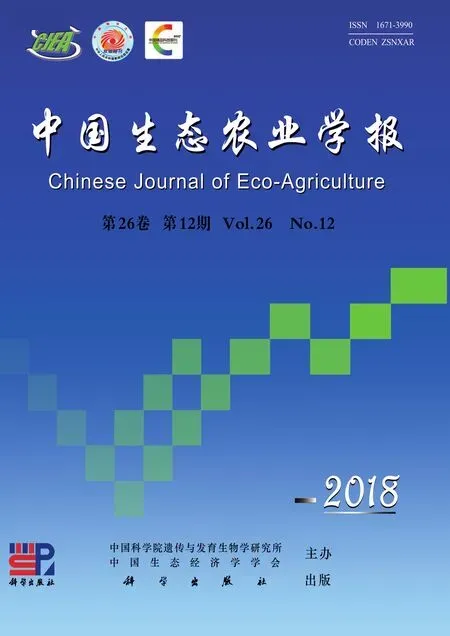有机无机肥配施对玉米-豇豆种植系统土壤N2O排放的影响*
2018-11-29帅艳菊刘天奇曹凑贵李成芳
帅艳菊, 刘天奇, 曹凑贵,2, 李成芳,2**
有机无机肥配施对玉米-豇豆种植系统土壤N2O排放的影响*
帅艳菊1, 刘天奇1, 曹凑贵1,2, 李成芳1,2**
(1. 农业部长江中游作物生理生态与耕作重点实验室/华中农业大学植物科学技术学院 武汉 430070; 2. 长江大学/长江大学主要粮食作物产业化湖北省协同创新中心 荆州 434023)
在等施氮量条件下, 比较有机肥与无机肥施用后旱地玉米-豇豆复种系统土壤硝化与反硝化作用、N2O排放与作物产量的变化, 有助于正确认识肥料施用对N2O排放的影响, 为制定大田合理的丰产减排措施提供理论依据。本研究通过田间试验, 利用静态箱技术和BaPS气压过程分离技术研究了不同肥料类型处理(无机肥、有机肥、有机无机肥配施)下玉米-豇豆种植系统土壤N2O排放、硝化与反硝化作用的变化特征。结果表明: 1)相对于单施无机肥或有机肥, 有机无机肥配施可显著降低土壤硝化作用速率; 在玉米生长季, 有机无机肥配施处理平均土壤硝化作用速率分别比化肥和有机肥处理显著降低了28.74%和13.96%, 豇豆生长季显著降低了24.66%和13.28%。土壤反硝化作用速率在各施肥处理间差异不显著。2)有机无机肥配施显著降低土壤N2O排放; 在玉米生长季, 有机无机肥配施处理分别比无机肥处理和有机肥处理显著降低33.44%和32.29%, 在豇豆生长季分别显著降低27.00%和15.14%。3)相关分析表明, 土壤N2O排放与硝化作用速率呈极显著相关, 而与反硝化作用速率呈不显著相关。4)有机无机配施处理玉米和豇豆产量最高。因此, 有机无机肥配施能有效降低玉米-豇豆系统土壤N2O排放和提高作物产量, 是一项丰产低N2O排放的施肥技术, 但长期有机无机肥配施对土壤N2O排放和作物产量的影响还需要进一步研究。
玉米-豇豆复种系统;有机无机肥配施; 硝化作用; 反硝化作用; N2O排放; 产量
随着全球气候的不断变化, 温室效应备受关注。N2O是最重要的温室气体之一, 在大气中的含量虽然远低于CO2, 但在100年的时间尺度上, 其增温潜势是CO2的268倍[1]。农业对N2O排放有重要影响, 其中旱地农田是大气N2O的重要排放源[1-2]。因此, 研究旱地农田N2O排放对于应对全球气候变化和实现农业可持续发展具有重要意义。
土壤硝化作用与反硝化作用在土壤氮循环中占据重要地位, 被认为是农田N2O排放的主要途径[3]。有研究指出土壤硝化与反硝化过程中产生的N2O约占生物圈释放到大气中N2O总量的70%~90%[4]。研究表明, 影响农田土壤硝化与反硝化过程的环境因子、土壤条件及农田管理措施等会对N2O排放产生重要的影响[3,5-6]。施肥作为影响农田生产的最重要措施, 是影响N2O排放的主要因素。研究发现, 由于化学氮肥施用引起的农田土壤N2O排放占全世界农业温室气体排放量的14%[7]。因此, 明确不同施肥措施下农田土壤N2O排放规律及提出相应的N2O减排措施是亟需研究的问题。当前, 有机无机氮肥配合施用是农田常见的施肥方式, 其依据作物不同生育期对养分的需要特点, 达到协调作物养分的平衡供应, 实现作物减肥增产[8]。对于有机无机氮肥配施对旱地农田土壤N2O排放的影响存在争议。例如, 董玉红等[9]对鲁西北黄河冲积平原的小麦()-玉米()复种模式的研究表明, 在等氮条件下, 与单施化学氮肥相比, 有机无机氮肥配施降低了土壤N2O排放。孟磊等[10]在河南封丘的长期(1989—2002年)定位试验研究发现, 等氮条件下单施无机氮肥、单施有机氮肥、有机无机氮肥配施3个处理的夏玉米-冬小麦复种模式土壤N2O排放量差异不显著。而在紫色土冬小麦-夏玉米复种系统N2O排放的研究指出, 有机无机氮肥配施和单施有机氮肥均较单施无机氮肥显著提高了N2O排放[11]。陈晨等[12]在宁夏油葵()田的研究也发现, 在不同的氮肥施用方式下, 有机无机氮肥配施处理土壤N2O排放量显著高于单施无机氮肥处理。综上, 由于试验地区的差异, 气候条件、土壤类型、耕作制度、有机肥类型等因素的不同, 有机无机肥配施对旱地土壤N2O排放的影响也存在明显差别。因此, 深入研究有机氮肥施用对旱地土壤N2O排放的影响对于进一步探寻既可保证作物产量又可有效降低N2O排放的施肥方式具有重要的意义。目前, 国内有关有机无机氮肥施用对旱地农田土壤N2O排放的研究多集中在华北、西南等地区, 而对华中地区的研究尚少[13]。为此, 本研究从合理施用有机肥的目的出发, 在等氮投入条件下, 以春玉米-夏豇豆()这一武汉地区常见的旱地复种模式为研究对象, 分析不同施肥模式下土壤N2O排放、硝化与反硝化速率的变化特征, 探索不同肥料类型对土壤N2O排放的影响, 以期为减少温室气体N2O排放和提高旱地玉米-豇豆种植产量提供理论依据。
1 材料与方法
1.1 试验区概况
试验于2017年3—9月在湖北省武汉市华中农业大学长期定位试验小区进行。试验开始前耕作层土壤基本性质为: 全氮1.15 g·kg-1、铵态氮6.63 mg·kg-1、硝态氮3.68 mg·kg-1、全磷0.39 g·kg-1、速效磷8.83 mg·kg-1、全钾8.67 g·kg-1、速效钾80.28 mg·kg-1、有机质10.56 g·kg-1。供试土壤为黏壤土, pH为7.03, 土壤容重为1.13 g·cm-3。玉米和豇豆种植方式均采用直播方式。
1.2 试验设计
试验设3个处理: 1)无机肥处理(I); 2)有机无机肥料配施处理(I+O); 3)有机肥处理(O)。随机区组设计, 4次重复, 小区面积为6 m2(2 m×3 m)。
玉米和豇豆供试品种分别为‘南粤868’彩甜糯玉米和‘裕丰海宝王’(长条型)。玉米于3月1日播种, 播种密度为60 000株∙hm-2, 播种深度3~5 cm, 底肥在播种前翻整地混施入土壤耕层, 分别于4月23日和5月28日追施拔节肥和穗肥; 豇豆于7月8日播种, 行株距为75 000株∙hm-2, 底肥在播种前混施入耕层, 8月12日追施一次花肥。玉米全生育期各处理的氮、磷、钾施用标准均为: 240 kg(N)∙hm-2、150 kg(P2O5)∙hm-2、210 kg(K2O)∙hm-2; 豇豆全生育期氮、磷、钾施用标准为: 180 kg(N)∙hm-2、90 kg(P2O5)∙hm-2、90 kg(K2O)∙hm-2。对于无机肥处理, 玉米季氮肥按底肥∶拔节肥∶穗肥为4∶3∶3(以纯氮计)施用, 豇豆季底肥、花肥中氮肥施用比例为1∶1(以纯氮计), 底肥与追肥均采用尿素(46%); 对于有机肥(复合微生物有机肥, 武汉合缘绿色生物股份有限公司生产, 其中N∶P2O5∶K2O=10%∶3%∶2%, 有效活菌数≥2 000万∙g-1)处理, 有机肥作为底肥一次性施用; 对于有机肥无机肥配施处理, 有机肥无机肥各自的供氮量占总施氮量的50%, 且作为底肥一次性施用。试验中, 根据肥料等量施用原则, 不足磷、钾肥以磷酸二铵(57% P2O5、15% N)和氯化钾(60% K2O)按施用标准补齐, 磷、钾肥均作为底肥一次性施用。具体施肥见表1。对于玉米与豇豆, 除了在播种后进行灌溉外, 其他时期均不浇水灌溉。
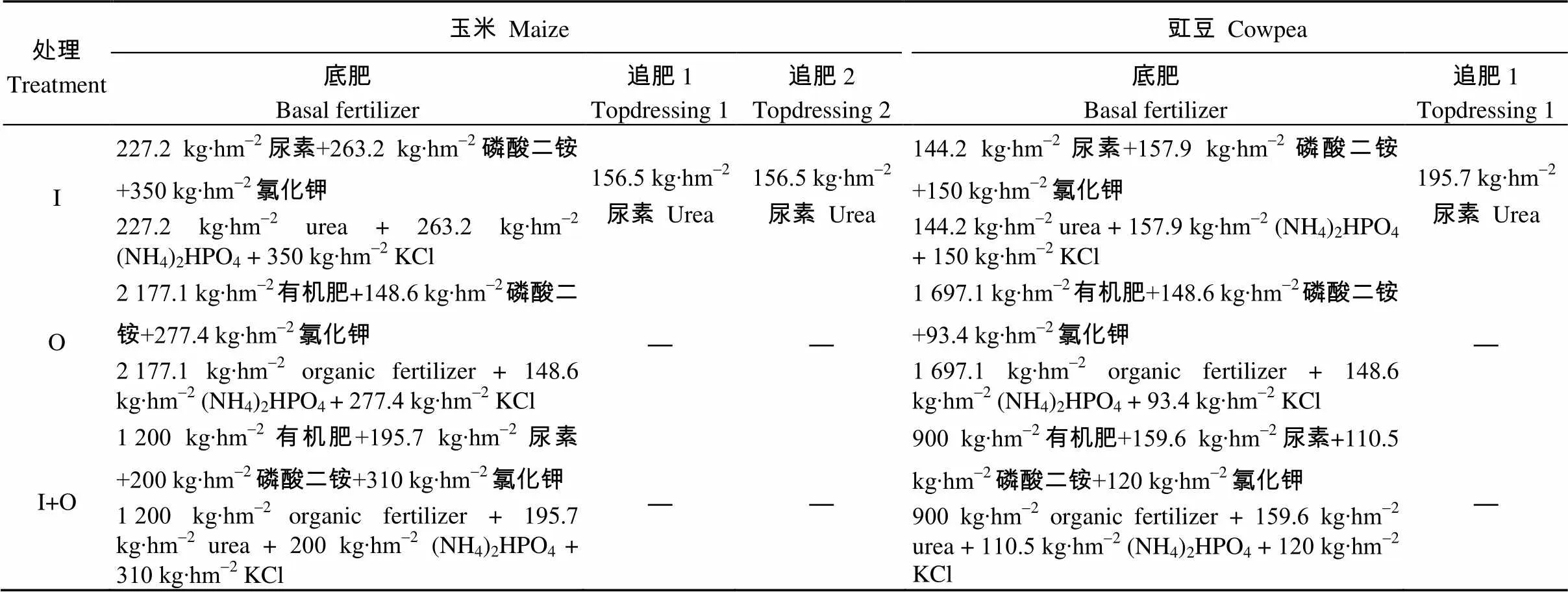
表1 不同处理肥料施用情况
I: 无机肥处理; O: 有机肥处理; I+O: 有机无机肥料配施处理。I: inorganic fertilizer; O: organic fertilizer; I+O: inorganic plus organic fertilizers.
1.3 样品采集与测定
1.3.1 N2O采集及测定
玉米-豇豆系统N2O通量采用静态暗箱-气相色谱法测定[14]。采样箱规格为直径0.38 m, 高0.5 m, 箱顶连接采气三通阀, 并设有小风扇和温度计, 用于充分混合箱内气体和测定箱内温度。玉米和豇豆生长季, 从播种到作物收获, 每隔7~10 d采样一次。采样在8:30—11:00进行, 在关箱后0 min、10 min、20 min和30 min, 用25 mL注射器抽取箱内混合均匀气体于真空玻璃瓶中。用改装后的Shimadzu GC-14B气相色谱分析气样中的N2O浓度, 检测器为ECD(电子捕获检测器)。检测器温度为330 ℃; 色谱柱温度为50 ℃; 通过对4个气样浓度进行线性回归, 得出气体排放速率, 并依据下面方程计算N2O通量[14]:
=××/×273/(273+) (1)
式中:为N2O通量(µg·m-2·h-1),为标准状态下气体密度(kg·m-3),为箱高(m),/为采气箱内气体浓度变化率,为采样过程中采样箱内的平均温度(℃)。
在玉米和豇豆的生育期内, N2O排放总量为每相邻两采样时期的气体排放量之和, 而每相邻的两采样时期的气体排放量为两相邻排放通量平均值与采样间隔时间的乘积[14]。
1.3.2 硝化作用与反硝化作用速率测定
采用气压过程分离法(BaPS)测定土壤硝化作用和反硝化作用速率[15]。BaPS是一种研究旱地土壤碳氮转化的方法, 其土壤氮循环监测系统主要由控温设备、培养室和传感器界面单元3部分组成。
在每次气样采集后进行土壤样品采集, 用环刀随机采集5点(0~5 cm)土样。将同一小区的5个重复样放入密封培养室中, 盖上置有传感器的盖子, 将控温设备温度设定为田间取样时的土壤温度。待系统平衡30 min后, 抽气检测培养室密封性。确定密封良好后输入样品总湿重、pH、含水量等必要的土壤参数, 便可进行培养测定, 时间为24 h。测定过程BaPS系统软件自动收集数据, 由线性回归分析可得到土壤总硝化速率和反硝化速率。
1.3.3 产量测定
在玉米成熟时将整个小区进行测产, 按照籽粒含水率的14%折算产量。当豇豆夹荚条粗细均匀、荚面豆粒不鼓起达到商业菜标准时开始采收[16], 直至收获结束。
1.4 数据处理
试验结果均以4次重复的平均值和标准差来表示。试验数据采用Microsoft Office进行整理分析和作图, 用Statistix 8.0软件进行方差分析, 采用LSD法进行显著性水平检验(<0.05)。
2 结果与分析
2.1 土壤硝化作用速率动态变化
在玉米生长季, 土壤硝化作用速率总体呈下降趋势, 变化范围为130.90~340.37 µg·kg-1·h-1(图1a)。对于处理I和I+O, 在每次氮肥施用后, 土壤硝化作用速率均迅速增加, 分别于3~4 d达到峰值, 随后逐渐降低。处理I+O平均土壤硝化作用速率为201.07 µg·kg-1·h-1, 分别比处理I(282.15 µg·kg-1·h-1)和O(233.69 µg·kg-1·h-1)显著降低28.74%(<0.01)和13.96%(<0.01)。
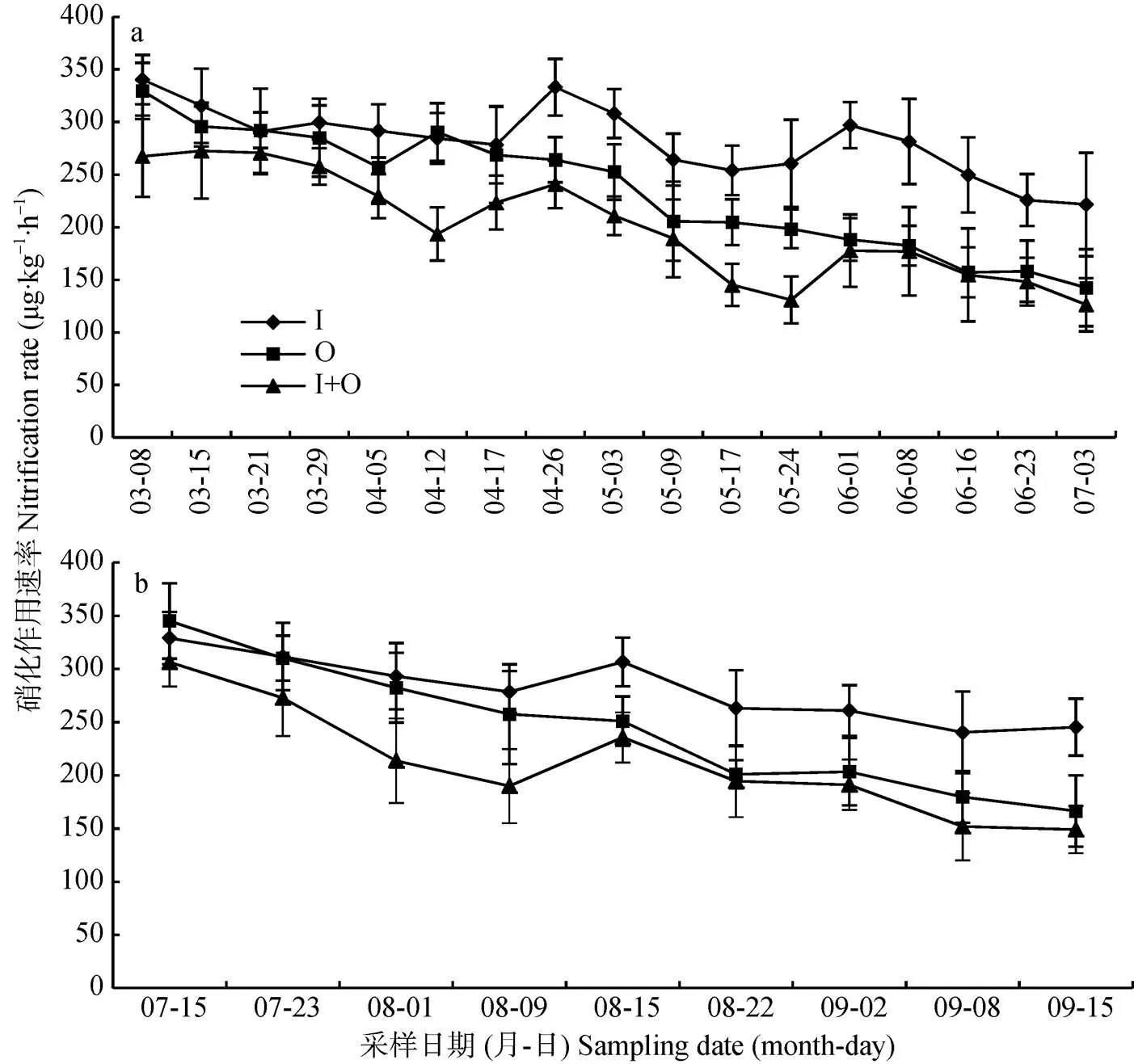
图1 玉米季(a)和豇豆季(b)不同施肥处理土壤硝化作用速率变化
在豇豆生长季, 各施肥处理土壤硝化作用速率总体呈明显下降趋势, 在145.11~348.75 µg·kg-1·h-1波动; 处理I和I+O在施肥后第3 d(8月15日)达到峰值(图1b)。处理I+O平均土壤硝化作用速率为211.66 µg·kg-1·h-1, 分别比处理I和O显著降低24.66%和13.28%。
2.2 土壤反硝化作用速率动态变化
各施肥处理土壤反硝化作用速率均随着玉米生长而逐渐降低(图2a)。施肥处理I、O和I+O平均土壤反硝化作用速率分别为160.28 µg·kg-1·h-1、163.99 µg·kg-1·h-1和160.13 µg·kg-1·h-1。土壤反硝化作用速率在各施肥处理间差异不显著。
在豇豆生长季,各施肥处理土壤反硝化作用速率也呈明显下降趋势(图2b)。施肥处理I、O和I+O平均土壤反硝化作用速率分别为162.83 µg·kg-1·h-1、170.39 µg·kg-1·h-1和172.01 µg·kg-1·h-1。土壤反硝化作用速率在各施肥处理间差异不显著。
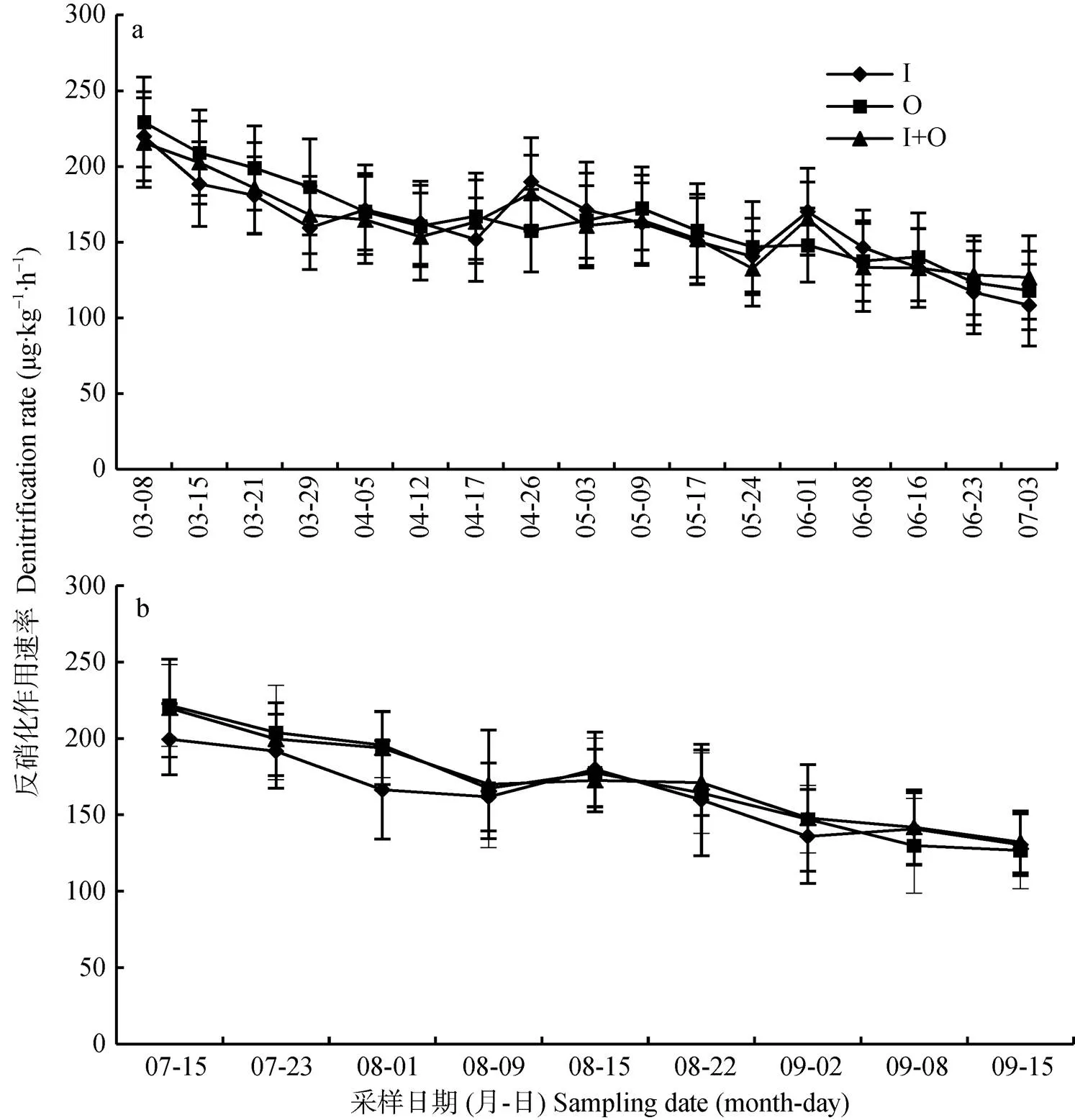
图2 玉米季(a)和豇豆季(b)不同处理土壤反硝化作用速率变化
2.3 土壤N2O通量动态变化
由图3可以看出, 在玉米和豇豆生长季, 土壤N2O通量均随作物生长而呈现明显的下降趋势, 且玉米生长前期土壤N2O通量显著高于豇豆生长前期。对于无机氮肥处理(I和I+O), 在每次氮肥施用后, 土壤N2O通量迅速达到峰值, 之后逐渐下降。在玉米生长季, 施肥处理I+O平均土壤N2O通量为279.54 µg·m-2·h-1, 比处理I和O分别显著降低33.44%(<0.01)和32.29%(<0.01)(图3a)。在豇豆生长季, 施肥处理I+O平均土壤N2O通量为188.07 µg·m-2·h-1, 比处理I和处理O分别显著降低27.00%和15.14%(图3b)。
2.4 土壤N2O排放与硝化、反硝化作用的相关性
各处理土壤N2O排放通量均与硝化作用速率呈极显著相关, 而与反硝化作用速率不显著(表2)。
2.5 作物产量与土壤N2O累积排放量
各施肥处理玉米和豇豆产量存在显著差异(表3)。处理I+O的玉米产量最高, 分别为处理I和O的1.71倍(<0.01)和1.23倍(<0.01); 处理I+O的豇豆产量为处理I的1.25倍(<0.05); 处理I+O周年总的产量最大, 为处理I和O的1.34倍(<0.01)和1.17倍(<0.01), 处理I和O间总的产量差异不显著。
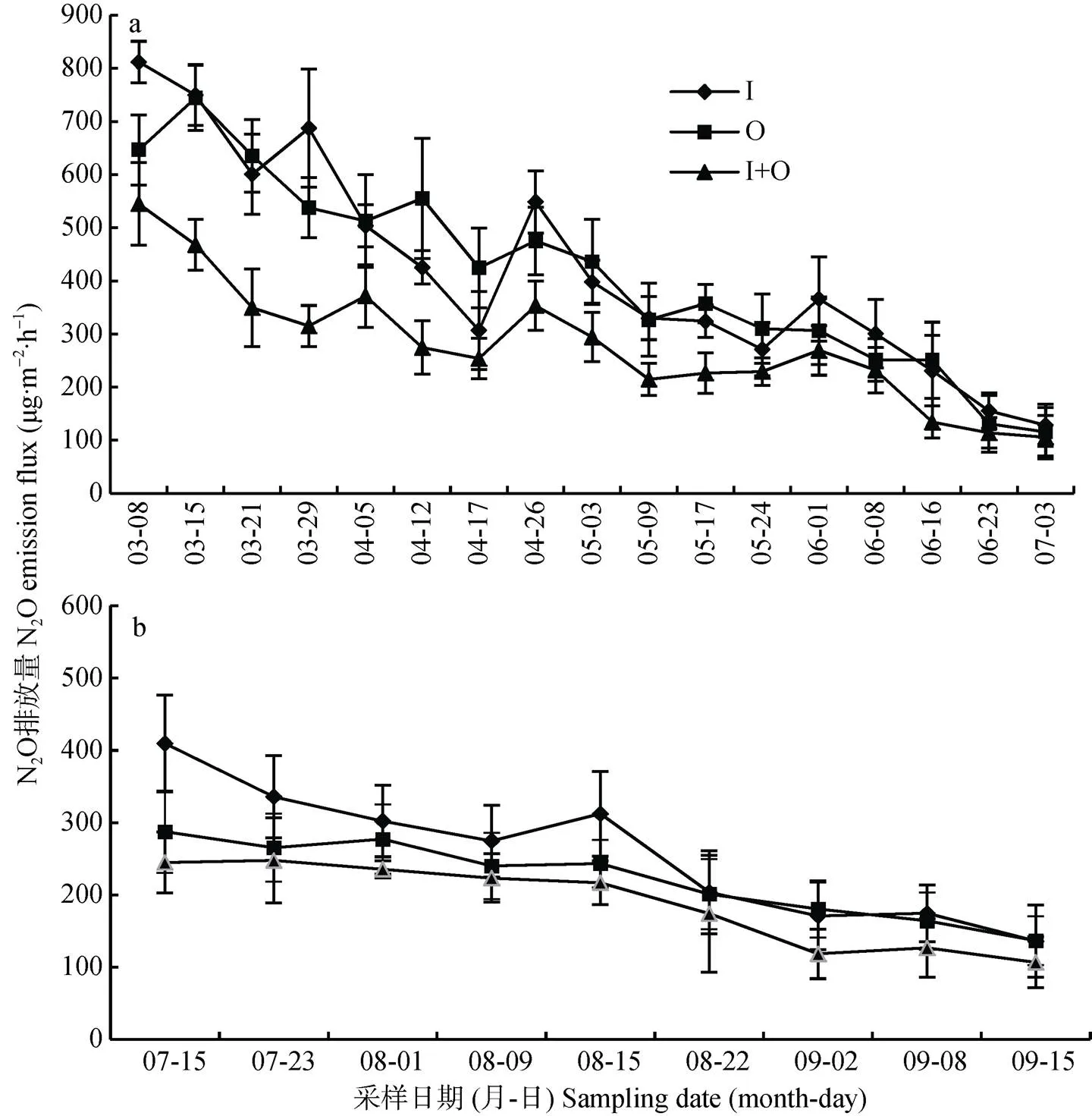
图3 玉米季(a)和豇豆季(b)不同处理土壤N2O排放通量变化
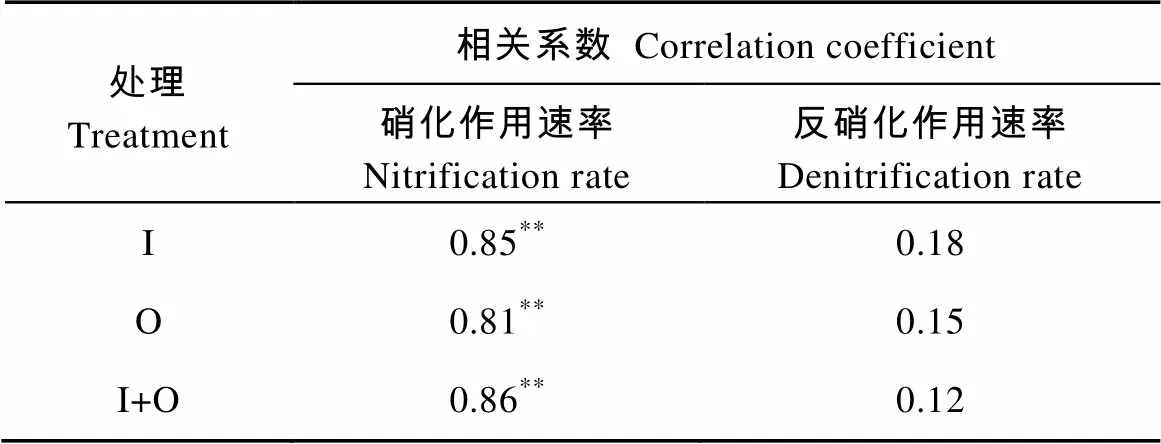
表2 N2O排放通量与硝化作用和反硝化作用的相关性
**: 0.01水平显著相关。**: significant correlation at 0.01 level (=64).
在玉米全生育期, 处理I+O的N2O累积排放量最小, 为7.70 kg·hm-2, 分别比处理I和O显著降低33.51%(<0.01)和32.51%(<0.01), 而处理I和O间N2O累积排放量差异不显著; 在豇豆全生育期, 处理I+O的N2O累积排放量最小, 比处理I显著降低25.77%(<0.05), 而处理I和O间N2O累积排放量差异不显著。

表3 不同施肥处理下玉米-豇豆系统产量与N2O累计排放量
同列不同字母表示5%水平差异显著。Different letters in the same column mean significant differences at 0.05 level.
3 讨论
3.1 土壤硝化与反硝化作用对N2O排放的影响
本研究N2O通量与硝化作用速率呈极显著正相关(表2), 表明硝化作用对N2O排放起主导作用, 这与朱永官等[3]的研究结果一致。本研究除了在播种时进行了一次灌溉, 在作物生长期间未进行人工灌溉, 利用自然降雨灌溉; 且期间人工中耕除草, 进一步改善了土体通气状况, 促进了硝化过程, 更有利于土壤N2O的排放。研究已指出, 好气条件下硝化作用是土壤N2O的主要排放途径[17]。林存刚[18]研究也指出, 旱田土壤中硝化N2O贡献率大于反硝化N2O贡献率, 硝化作用是N2O主要排放源。本研究还发现, 与单施无机肥处理相比, 有机肥处理(O和I+O)硝化作用显著降低。这可能是无机肥的施用促进了脲酶活性, 提高了硝化作用的底物浓度, 促进了硝化作用; 而有机肥施用虽然提高了土壤氮的矿化作用, 但伴随氧气的消耗, 硝化作用受到一定程度的抑制[19]。何飞飞等[13]的研究也指出, 在等氮投入下, 与单施无机肥处理相比, 有机肥或有机无机配施处理的土壤硝化作用降低。本研究玉米季和豇豆季N2O累计排放量分别为7.70~11.58 kg·hm-2和2.88~3.88 kg·hm-2, 明显高于翟振等[20](0.61~1.49 kg·hm-2)、王秀斌等[21](0.67~3.16 kg·hm-2)、黄晶等[22](0.15~1.43 kg·hm-2)与李燕青等[5](0.31~3.04 kg·hm-2)在华北平原的研究结果。这可能与不同试验点的温度差异有关。温度是影响硝化作用的重要因素, 温度增加有利硝化细菌的活性增强[23-24]。本研究地处华中地区, 试验期间(3月到9月)温度明显高于华北平原, 因此高温有利于提高硝化微生物的活性, 促进硝化作用, 进而提高N2O的排放。
3.2 不同肥料类型对玉米-豇豆系统土壤N2O排放的影响
本研究中玉米-豇豆系统土壤硝化作用率、反硝化作用速率和N2O通量均在作物生长初期呈现较高水平, 这与底肥施用量较大有关。大量的氮肥为土壤硝化与反硝化微生物提供充足的氮源[25], 提高了微生物活性, 促进了N2O的排放。追肥后3~4 d有机肥处理和有机无机肥配施处理N2O通量迅速上升达到峰值, 这与前人的研究结果一致[26]。
研究结果表明, 有机无机肥配施处理土壤N2O排放量最小。究其原因, 可能是有机无机肥配施可改善土壤理化性质, 调节相关微生物活性, 在作物生长前期增强土壤对氮素的生物固持, 而在作物生长中、后期促进土壤氮素释放, 提高土壤对氮素的缓冲能力, 协调土壤供氮和作物需氮的关系, 从而在相同施氮量的情况下能有效减少氮素向N2O的转化[27-29]。梁斌[29]对不同施肥处理下氮肥在小麦-玉米复种系统的运移特性进行了研究, 发现在小麦拔节期单施化肥处理和尿素与秸秆1∶1配施处理分别有10%和14%的氮肥被微生物固持于土壤中, 随后被固持的氮素又分别有71%和84%释放供小麦利用, 复种结束时配施处理的土壤氮肥总回收率达85%。同时, 本研究也表明, 无机肥与有机肥处理N2O排放量没有显著差异。首先, 有机肥氮素形态主要以有机态为主, 其供氮能力缓慢的特点导致前期氮素供应能力不及单施无机肥, 因此N2O排放低于单施无机肥; 而后期有机肥的不断矿化能减缓土壤速效氮素的消耗, 为微生物硝化与反硝化作用提供了充足氮素, 促进了N2O产生[12]。其次, 有研究指出, 在等氮条件下, 单施有机肥和无机肥处理间N2O排放差异不显著, 主要受外源碳供应水平的制约[30]。虽然本试验开始于2013年, 但4年试验没有导致各处理间有机碳有显著差异(数据未提供)。本试验结果与李燕青等[5]的研究结果不同。李燕青等[5]报道, 在等量氮条件下, 玉米生长季无机肥处理产生的N2O总量是有机肥处理的2.01~2.81倍。分析其原因可能与土壤pH有关。李燕青等[5]试验土壤pH为8.0~8.5, 而本试验土壤pH为7.03。已有研究表明[31], pH 7~10范围内, N2O排放随pH上升而呈下降趋势。因此, 本研究较高的N2O排放缓解了处理的影响。事实上, 有机肥中有效氮的缓慢释放特性决定了土壤N2O的排放是一个缓慢的过程, 本研究只对作物季进行了测定, 因此可能降低了对有机肥处理N2O排放量的估算[32-33]。
3.3 不同肥料类型对玉米-豇豆种植系统产量的影响
许多研究指出有机无机肥配施可以显著提高作物的产量[34-35]。本研究结果亦表明与单施有机肥或无机肥相比, 有机无机肥配施可以显著提高作物产量。主要是有机无机肥配施能改善土壤供氮和作物需氮的关系, 提高氮素利用率[34]。也有研究表明配施有机肥可增加土壤中大团聚体数量, 改善土壤结构[36], 促进作物根系生长, 提高水肥利用效率[37]。本研究表明, 单施无机肥与有机肥处理作物产量没有显著差异(表3)。其原因可能是单施无机肥土壤矿质氮释放较快, 含量迅速下降, 导致作物生长后期氮素供应不足; 而对于单施有机肥处理, 虽然有机肥中速效氮含量很低, 且其释放过程较为缓慢[35], 但2013年开始连续4年的施用有机肥, 其后效一定程度上弥补了上述的不足。然而, 张欣等[38]研究发现, 在等氮条件下, 单施有机肥处理稻米产量略低于常规施肥处理单施有机肥, 其原因可能是有机肥中速效氮含量很低, 且其释放过程缓慢, 无法及时满足作物生长发育的需要。不同的研究结果可能与试验所使用的有机肥类型不同有关。不同形态的有机肥由于其氮形态以及速效态氮的含量不同[39], 因此对产量的影响有所不同。
春玉米-夏豇豆是华中地区常见的复种模式, 该模式春玉米收获后保留玉米秸秆作为夏播豇豆的支架, 这样既节省了豇豆支架的搭建用工和材料费用, 同时在炎热的夏季也能为豇豆苗期生长遮阴[40]。然而, 为了追求高产, 过量的化学氮肥被施用, 由此引发的环境负效应越来越受到人们的关注。因此, 加强该复种模式下氮肥的合理使用, 特别是有机无机肥的合理搭配的研究, 对于发展丰产与低N2O排放的环境友好型种植模式具有重要意义。
4 结论
施肥显著影响玉米和豇豆复种系统土壤硝化作用速率、N2O排放和作物产量。有机无机肥配施可显著降低土壤硝化速率和N2O的排放, 提高玉米和豇豆产量。因此, 我们的研究结果表明, 有机无机肥配施可以实现玉米-豇豆生产系统的高产与N2O减排的协同, 可作为华中地区玉米-豇豆可持续生产的优化施肥模式。
[1] IPCC. Climate Change 2013: The Physical Science Basis. Contribution of Working Group Ⅰ to the Fifth Assessment Report of the Intergovernmental Panel on Climate Change[R]. Cambridge: Cambridge University Press, 2013
[2] BURNEY J A, DAVIS S J, LOBELL D B. Greenhouse gas mitigation by agricultural intensification[J]. Proceedings of the National Academy of Sciences of the United States of America, 2010, 107(26): 12052–12057
[3] 朱永官, 王晓辉, 杨小茹, 等. 农田土壤N2O产生的关键微生物过程及减排措施[J]. 环境科学, 2014, 35(2): 792–800 ZHU Y G, WANG X H, YANG X L, et al. Key microbial processes in nitrous oxide emissions of agricultural soil and mitigation strategies[J]. Environmental Science, 2014, 35(2): 792–800
[4] 孙志强, 郝庆菊, 江长胜, 等. 农田土壤N2O的产生机制及其影响因素研究进展[J]. 土壤通报, 2010, 41(6): 1524–1530 SUN Z Q, HAO Q J, JIANG C S, et al. Advances in the study of nitrous oxide production mechanism and its influencing factors in agricultural soils[J]. Chinese Journal of Soil Science, 2010, 41(6): 1524–1530
[5] 李燕青, 唐继伟, 车升国, 等. 长期施用有机肥与化肥氮对华北夏玉米N2O和CO2排放的影响[J]. 中国农业科学, 2015, 48(21): 4381–4389 LI Y Q, TANG J W, CHE S G, et al. Effect of organic and inorganic fertilizer on the emission of CO2and N2O from the summer maize field in the North China Plain[J]. Scientia Agricultura Sinica, 2015, 48(21): 4381–4389
[6] KRAUSS M, KRAUSS H M, SPANGLER S, et al. Tillage system affects fertilizer-induced nitrous oxide emissions[J]. Biology and Fertility of Soils, 2017, 53(1): 49–59
[7] TIERLING J, KUHLMANN H. Emissions of nitrous oxide (N2O) affected by pH-related nitrite accumulation during nitrification of N fertilizers[J]. Geoderma, 2018, 310: 12–21
[8] 郝小雨, 高伟, 王玉军, 等. 有机无机肥料配合施用对设施菜田土壤N2O排放的影响[J]. 植物营养与肥料学报, 2012, 18(5): 1073–1085HAO X Y, GAO W, WANG Y J, et al. Effects of combined application of organic manure and chemical fertilizers on N2O emission from greenhouse vegetable soil[J]. Plant Nutrition and Fertilizer Science, 2012, 18(5): 1073–1085
[9] 董玉红, 欧阳竹, 李运生, 等. 不同施肥方式对农田土壤CO2和N2O排放的影响[J]. 中国土壤与肥料, 2007, (4): 34–39 DONG Y H, OUYANG Z, LI Y S, et al. Influence of different fertilization on CO2and N2O fluxes from agricultural soil[J]. Soil and Fertilizer Sciences in China, 2007, (4): 34–39
[10] 孟磊, 蔡祖聪, 丁维新. 长期施肥对华北典型潮土N分配和N2O排放的影响[J]. 生态学报, 2008, 28(12): 6197–6203 MENG L, CAI Z C, DING W X. Effects of long-term fertilization on N distribution and N2O emission in fluvo-aquci soil in North China[J]. Acta Ecologica Sinica, 2008, 28(12): 6197–6203
[11] 肖乾颖, 黄有胜, 胡廷旭, 等. 施肥方式对紫色土农田生态系统N2O和NO排放的影响[J]. 中国生态农业学报, 2018, 26(2): 203–213 XIAO Q Y, HUANG Y S, HU T X, et al. Effects of fertilization regimes on N2O and NO emissions from agro-ecosystems of purplish soil[J]. Chinese Journal of Eco-Agriculture, 2018, 26(2): 203–213
[12] 陈晨, 许欣, 毕智超, 等. 生物炭和有机肥对菜地土壤N2O排放及硝化、反硝化微生物功能基因丰度的影响[J]. 环境科学学报, 2017, 37(5): 1912–1920 CHEN C, XU X, BI Z C, et al. Effects of biochar and organic manure on N2O emissions and the functional gene abundance of nitrification and denitrification microbes under intensive vegetable production[J]. Acta Scientiae Circumstantiae, 2017, 37(5): 1912–1920
[13] 何飞飞, 梁运姗, 易珍玉, 等. 有机无机肥配施对酸性菜地土壤硝化作用的影响[J]. 植物营养与肥料学报, 2014, 20(3): 534–540 HE F F, LIANG Y S, YI Z Y, et al. Effects of combined application of manure and chemical fertilizer on the nitrification in acid vegetable soil[J]. Journal of Plant Nutrition and Fertilizer, 2014, 20(3): 534–540
[14] ZHENG X H, WANG M X, WANG Y S, et al. Comparison of manual and automatic methods for measurement of methane emission from rice paddy fields[J]. Advances in Atmospheric Sciences, 1998, 15(4): 569–579
[15] INGWERSEN J, BUTTERBACH-BAHL K, GASCHE R, et al. Barometric process separation: New method for quantifying nitrification, denitrification, and nitrous oxide sources in soil[J]. Soil Science Society of America Journal, 1999, 63(1): 117–128
[16] 梁银丽, 熊亚梅, 吴燕, 等. 日光温室豇豆产量和品质对水分和氮素水平的响应[J]. 水土保持学报, 2008, 22(5): 142–145 LIANG Y L, XIONG Y M, WU Y, et al. The response of cowpea yield and quality to soil moisture and nitrogen in solar greenhouse[J]. Journal of Soil and Water Conservation, 2008, 22(5): 142–145
[17] MATHIEU O, HÉNAULT C, LÉVÊQUE J, et al. Quantifying the contribution of nitrification and denitrification to the nitrous oxide flux using15N tracers[J]. Environmental Pollution, 2006, 144(3): 933–940
[18] 林存刚. 硝化与反硝化作用对农田土壤N2O排放的贡献[D]. 重庆: 西南大学, 2006 LIN C G. Contributions of nitrification & denitrification to emission of nitrous oxide in farmland soil[D]. Chongqing: Southwest University, 2006
[19] 王军, 申田田, 车钊, 等. 有机和无机肥配比对黄褐土硝化和反硝化微生物丰度及功能的影响[J]. 植物营养与肥料学报, 2018, 24(3): 641–650 WANG J, SHEN T T, CHE Z, et al. Effects of combination of organic and inorganic fertilizers on abundances of nitrifiers and denitrifiers and their function in yellow-cinnamon soil[J]. Journal of Plant Nutrition and Fertilizers, 2018, 24(3): 641–650
[20] 翟振, 王立刚, 李虎, 等. 有机无机肥料配施对春玉米农田N2O排放及净温室效应的影响[J]. 农业环境科学学报, 2013, 32(12): 2502–2510 ZHAI Z, WANG L G, LI H, et al. Nitrous oxide emissions and net greenhouse effect from spring-maize field as influenced by combined application of manure and inorganic fertilizer[J]. Journal of Agro-Environment Science, 2013, 32(12): 2502–2510
[21] 王秀斌, 梁国庆, 周卫, 等. 优化施肥下华北冬小麦/夏玉米轮作体系农田反硝化损失与N2O排放特征[J]. 植物营养与肥料学报, 2009, 15(1): 48–54 WANG X B, LIANG G Q, ZHOU W, et al. Effect of optimized nitrogen application on denitrification losses and N2O emissions from soil in winter wheat/summer corn rotation system in North China[J]. Plant Nutrition and Fertilizer Science, 2009, 15(1): 48–54
[22] 黄晶, 张杨珠, 刘宏斌, 等. 长期不同施肥条件下红壤小麦和玉米季CO2、N2O排放特征[J]. 生态与农村环境学报, 2011, 27(4): 7–13 HUANG J, ZHANG Y Z, LIU H B, et al. CO2and N2O emissions from red soil during wheat and corn growing seasons under different patterns of long-term fertilization[J]. Journal of Ecology and Rural Environment, 2011, 27(4): 7–13
[23] GUNTIÑAS M E, LEIRÓS M C, TRASAR-CEPEDA C, et al. Effects of moisture and temperature on net soil nitrogen mineralization: A laboratory study[J]. European Journal of Soil Biology, 2012, 48: 73–80
[24] 郎漫, 李平, 张小川. 土地利用方式和培养温度对土壤氮转化及温室气体排放的影响[J]. 应用生态学报, 2012, 23(10): 2670–2676 LANG M, LI P, ZHANG X C. Effects of land use type and incubation temperature on soil nitrogen transformation and greenhouse gas emission[J]. Chinese Journal of Applied Ecology, 2012, 23(10): 2670–2676
[25] 范晓晖, 朱兆良. 旱地土壤中的硝化-反硝化作用[J]. 土壤通报, 2002, 33(5): 385–391 FAN X H, ZHU Z L. Nitrification and denitrification in upland soils[J]. Chinese Journal of Soil Science, 2002, 33(5): 385–391
[26] 万伟帆, 美丽, 红梅, 等. 内蒙古阴山北麓滴灌马铃薯田氨挥发和氧化亚氮排放特征[J]. 灌溉排水学报, 2016, 35(8): 36–41 WAN W F, MEI L, HONG M, et al. Characteristics of ammonia volatilization and nitrous oxide emission under drip irrigated potato in North of Yinshan of Inner Mongolia[J]. Journal of Irrigation and Drainage, 2016, 35(8): 36–41
[27] LIANG B, ZHAO W, YANG X Y, et al. Fate of nitrogen-15 as influenced by soil and nutrient management history in a 19-year wheat-maize experiment[J]. Field Crops Research, 2013, 144: 126–134
[28] 邢素丽, 韩宝文, 刘孟朝, 等. 有机无机配施对土壤养分环境及小麦增产稳定性的影响[J]. 农业环境科学学报, 2010, 29(S1): 135–140 XING S L, HAN B W, LIU M C, et al. The effect of NPK fertilizer combined with soil organic manure on soil nutrition and wheat yield increasing[J]. Journal of Agro-Environment Science, 2010, 29(S1): 135–140
[29] 梁斌. 有机肥与化肥长期配施协调土壤供氮的效应及机理[D]. 杨凌: 西北农林科技大学, 2012 LIANG B. Effect of long-term combined application of manure and inorganic fertilizers on soil nitrogen availability and its mechanism[D]. Yangling: Northwest A&F University, 2012
[30] CHADWICK D R, PAIN B F, BROOKMAN S K E. Nitrous oxide and methane emissions following application of animal manures to grassland[J]. Journal of Environmental Quality, 2000, 29(1): 277–287
[31] 黄国宏, 陈冠雄, 韩冰. 土壤含水量与N2O产生途径研究[J]. 应用生态学报, 1999, 10(1): 53–56 HUANG G H, CHEN G X, HAN B. Relationships between soil water content and N2O production[J]. Chinese Journal of Applied Ecology, 1999, 10(1): 53–56
[32] GREGORICH E G, ROCHETTE P, VANDENBYGAART A J, et al. Greenhouse gas contributions of agricultural soils and potential mitigation practices in Eastern Canada[J]. Soil and Tillage Research, 2005, 83(1): 53–72
[33] ZHANG J, WANG M Y, CAO Y C, et al. Replacement of mineral fertilizers with anaerobically digested pig slurry in paddy fields: Assessment of plant growth and grain quality[J]. Environmental Science and Pollution Research, 2017, 24(10): 8916–8923
[34] 孟琳, 张小莉, 蒋小芳, 等. 有机肥料氮替代部分化肥氮对稻谷产量的影响及替代率[J]. 中国农业科学, 2009, 42(2): 532–542 MENG L, ZHANG X L, JIANG X F, et al. Effects of partial mineral nitrogen substitution by organic fertilizer nitrogen on the yields of rice grains and their proper substitution rate[J]. Scientia Agricultura Sinica, 2009, 42(2): 532–542
[35] 郑凤霞, 董树亭, 刘鹏, 等. 长期有机无机肥配施对冬小麦籽粒产量及氨挥发损失的影响[J]. 植物营养与肥料学报, 2017, 23(3): 567–577 ZHENG F X, DONG S T, LIU P, et al. Effects of combined application of manure and chemical fertilizers on ammonia volatilization loss and yield of winter wheat[J]. Journal of Plant Nutrition and Fertilizer, 2017, 23(3): 567–577
[36] LIU C A, LI F R, ZHOU L M, et al. Effect of organic manure and fertilizer on soil water and crop yields in newly-built terraces with loess soils in a semi-arid environment[J]. Agricultural Water Management, 2013, 117: 123–132
[37] 李絮花, 杨守祥, 于振文, 等. 有机肥对小麦根系生长及根系衰老进程的影响[J]. 植物营养与肥料学报, 2005, 11(4): 467–472 LI X H, YANG S X, YU Z W, et al. Effects of organic manure application on growth and senescence of root in winter wheat[J]. Plant Nutrition and Fertilizer Science, 2005, 11(4): 467–472
[38] 张欣, 施利利, 刘晓宇, 等. 不同施肥处理对水稻产量、食味品质及蛋白质组分的影响[J]. 中国农学通报, 2010, 26(4): 104–108 ZHANG X, SHI L L, LIU X Y, et al. Effect of different fertilizer treatments on rice yield, grain quality and protein fraction content[J]. Chinese Agricultural Science Bulletin, 2010, 26(4): 104–108
[39] WEI W L, YAN Y, CAO J, et al. Effects of combined application of organic amendments and fertilizers on crop yield and soil organic matter: An integrated analysis of long-term experiments[J]. Agriculture, Ecosystems & Environment, 2016, 225: 86–92
[40] 赵丹, 戴维, 罗德木, 等. 麦冬—玉米—豇豆高效立体套作栽培技术[J]. 现代农业科技, 2017, (24): 80–81 ZHAO D, DAI W, LUO D M, et al. Cultural technology of high yield dwarf lilyturf tuber-maize- cowpea cropping system[J]. Modern and Agricultural Science and Technology, 2017, (24): 80–81
Effect of combined application of organic and inorganic fertilizers on soil nitrous oxide emission in maize-cowpea systems in central China*
SHUAI Yanju1, LIU Tianqi1, CAO Cougui1,2, LI Chengfang1,2**
(1. Key Laboratory of Crop Ecophysiology and Farming Systems in the Middle Reaches of Yangtze River of Ministry of Education / College of Plant Science & Technology, Huazhong Agricultural University, Wuhan 430070, China; 2. Yangtze University / Hubei Collaborative Innovation Center for Grain Industry, Yangtze University, Jingzhou 434023, China)
Nitrous oxide (N2O) is an important greenhouse gas that causes stratospheric ozone destruction. Application of chemical nitrogen fertilizers in upland cultivation systems is an important source of atmospheric N2O. It is important to determine the effects of nitrogen fertilization on N2O emissions in upland field in Central China where the relative researches is less conducted. In this study, soil nitrification and denitrification rates, N2O emissions and crop yields were investigated under application of organic and inorganic fertilizers with the same amounts of N in the field. Therefore in 2017, a field experiment was conducted to investigate the effects of different nitrogen fertilizer sources [inorganic nitrogen fertilizer (I), organic nitrogen fertilizer (O) and inorganic plus organic nitrogen fertilizers (I+O)] on nitrification rate, denitrification rate, N2O emission and crop yield under a maize-cowpea cropping system in Central China. Emission of N2O was measured by the static chamber approach and the rates of nitrification and denitrification measured by Barometric Process Separation (BaPS). The results showed that the rate of nitrification ranged from 130.90 µg·kg-1·h-1to 340.37 µg·kg-1·h-1in maize season, and from 145.11 µg·kg-1·h-1to 348.75 µg·kg-1·h-1in cowpea season. Application of organic nitrogen significantly affected soil nitrification rate. Compared with I and O treatments, I+O treatment significantly reduced soil nitrification rate respectively by 28.74% and 13.96% in maize season, and by 24.66% and 13.28% in cowpea season. However, no significant differences were observed in the rate of denitrification among three treatments. Nitrogen fertilization significantly enhanced N2O flux, with N2O flux peak observed immediately after nitrogen fertilizer application. The combined application of inorganic and organic nitrogen fertilizers markedly influenced N2O emission. The mean N2O flux in maize season under I+O treatment was (279.54±116.58) µg·m-2·h-1, which was 33.44% (< 0.01) and 32.29% (< 0.01) lower than that under I and O treatments. In cowpea season, mean flux under I+O treatment [(188.07±57.63) µg·m-2·h-1] decreased significantly by 27.00% and 15.14%, compared with that under I and O treatments. Moreover, compared with I and O treatments, I+O treatment significantly reduced cumulative N2O emission respectively by 33.51% and 32.51% in maize season, and by 25.77% and 15.04% in cowpea season. However, there were no significant differences in N2O flux and cumulative N2O emission between I and O treatments. Linear correlation analysis showed that N2O emission was closely related with nitrification rate. Yields of maize and cowpea varied among different treatments and I+O treatment had the highest yields of maize and cowpea. Yield of maize under I+O treatment was 1.71 and 1.23 times that under I and O treatments, and yield of cowpea under I+O treatment was 13.4 and 1.17 times that under I and O treatments, respectively. No significant difference was found in cowpea yield between I and O treatments. Our results suggested that combined application of organic and inorganic nitrogen fertilizers effectively reduced soil N2O emissions and increased crop yield in maize-cowpea cropping systems in Central China. The study had important implications for high-yield, low-carbon crop cultivation in China.
Maize-cowpea cropping system; Combined application of organic and inorganic fertilizers; Nitrification; Denitrification; N2O emission; Yield
, E-mail: lichengfang@126.com
Feb. 28, 2018;
Jun. 28, 2018
S145.6
A
1671-3990(2018)12-1763-10
10.13930/j.cnki.cjea.180191
* 国家重点研发计划项目(2017YFD0301403)、国家自然科学基金项目(31671637)和湖北省自然科学基金项目(2018CFB608)资助
李成芳, 主要研究方向为农业生态与耕作制度。E-mail: lichengfang@126.com
帅艳菊, 主要研究方向为农业生态学。E-mail: 2396567435@qq.com
2018-02-28
2018-06-28
* This study was supported by the National Key Research and Development Project of China (2017YFD0301403), the National Natural Science Foundation of China (31671637) and the Natural Science Foundation of Hubei Province (2018CFB608).
帅艳菊, 刘天奇, 曹凑贵, 李成芳. 有机无机肥配施对玉米-豇豆种植系统土壤N2O排放的影响[J]. 中国生态农业学报, 2018, 26(12): 1763-1772
SHUAI Y J, LIU T Q, CAO C G, LI C F. Effect of combined application of organic and inorganic fertilizers on soil nitrous oxide emission in maize-cowpea systems in central China[J]. Chinese Journal of Eco-Agriculture, 2018, 26(12): 1763-1772
